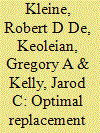| Srl | Item |
| 1 |
ID:
122745


|
|
|
|
|
| Publication |
2013.
|
| Summary/Abstract |
Plug-in hybrid electric vehicles (PHEVs) use grid electricity as well as on-board gasoline for motive force. These multiple energy sources make prediction of PHEV energy consumption challenging and also complicate evaluation of their environmental impacts. This paper introduces a novel PHEV energy consumption modeling approach and compares it to a second approach from the literature, each using actual trip patterns from the 2009 National Household Travel Survey (NHTS). The first approach applies distance-dependent fuel efficiency and on-road electricity consumption rates based on naturalistic or real world, driving information to determine gasoline and electricity consumption. The second uses consumption rates derived in accordance with government certification testing. Both approaches are applied in the context of a location-specific case study that focuses on the state of Michigan. The two PHEV models show agreement in electricity demand due to vehicle charging, gasoline consumption, and life cycle environmental impacts for this case study. The naturalistic drive cycle approach is explored as a means of extending location-specific driving data to supplement existing PHEV impact assessments methods.
|
|
|
|
|
|
|
|
|
|
|
|
|
|
|
|
| 2 |
ID:
105736


|
|
|
|
|
| Publication |
2011.
|
| Summary/Abstract |
The use of ethanol as a fuel has been attracting increasing attention in countries that are interested in reducing their dependence on imported oil and lowering their greenhouse gas emissions. Despite this growing interest, the global ethanol market is still incipient because of the small number of producing countries, the lack of technical standardization and the existence of tariff and non-tariff trade barriers. New laws have taken effect in 2010 in the United States and the European Union imposing domestic requirements for sustainable production of ethanol. Although these are generally positive developments, they can create greater difficulties for the development of an international ethanol market. This work examines the technical barriers posed by these new laws and how they can be resolved under the auspices of the World Trade Organization. In addition, this work analyses the Brazilian and Caribbean cases discussing to what extent these new technical barriers will affect ethanol production and exports arising from these countries.
|
|
|
|
|
|
|
|
|
|
|
|
|
|
|
|
| 3 |
ID:
098612


|
|
|
|
|
| Publication |
2010.
|
| Summary/Abstract |
Photovoltaic electricity has the potential to mitigate CO2 emissions from the grid. A methodology to more accurately evaluate CO2 abatement by PV electricity is developed. We develop a capacity factor based dispatching model to evaluate marginal abatement in the load zones of ERCOT and CAISO, and compare it to the abatement using national, regional and state average resource profiles. The average cases over-estimated and under-estimated CO2 abatement in ERCOT and CAISO, respectively. Marginal abatement was lower by 17% than the average cases in ERCOT, due to the predominant displacement of the low carbon natural gas plants at the margin. In CASIO, marginal abatement was higher (1.3-2.4 times) than that of the average cases due to the displacement of highly inefficient gas plants at the margin. We demonstrate that actual CO2 abatement of PV electricity is dependent on both peak load resources and capacity of installations. Subsequently, we develop a CO2 indicator that can be used as a guideline for selecting PV installation sites to derive maximum abatement. Installing photovoltaics in regional areas of MRO, SPP and RFC was determined to be most beneficial. The results of this study can guide energy planning and CO2 mitigation policy-making using photovoltaics in the future.
|
|
|
|
|
|
|
|
|
|
|
|
|
|
|
|